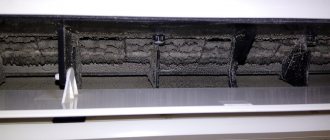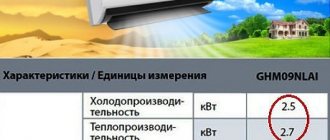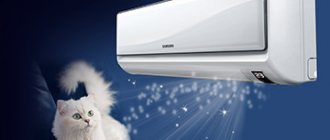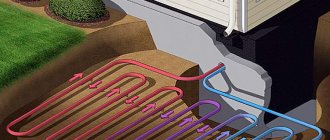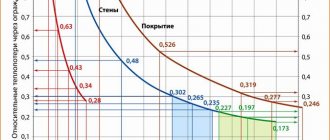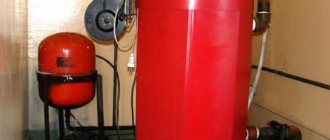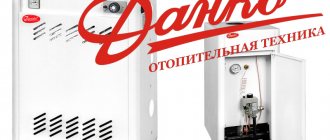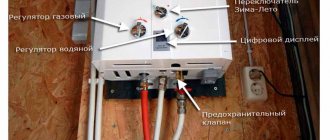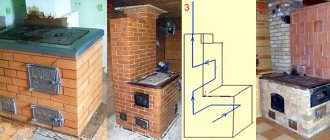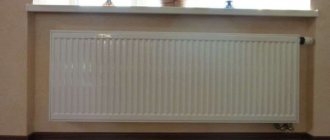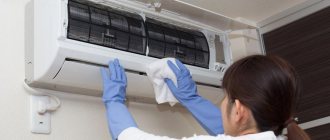Minimum temperature
At what temperature can the air conditioner be turned on for heating? – there is no clear answer to this question. It all depends on the model and manufacturer. Some models can operate for heating at -10, and some only at +5.
Inverter air conditioners have a lower minimum operating temperature. than non-inverter ones. Below is a table of minimum temperatures for the most popular air conditioner models (we replaced the model power with the ** symbol):
| Air conditioner model | Minimum temperature for heating operation |
| Cooper&Hunter CH-S**FTXLA | -25 |
| Toshiba RAS-**U2KH3S-EE / RAS-**U2AH3S-EE | -5 / -10 |
| Mitsubishi Electric MUZ-FH**VE | -15 / -16 |
| Panasonis CS-HE**QKD/CU-HE**QKD | -15 / -16 |
| Midea MSR-**ARDN1 | 0 |
| DAIKIN FTXB20/RXB20 | -15 |
Setup recommendations
Before turning on the warm air on the air conditioner, you must carefully study the operating instructions. Every manufacturer tries to stand out in order to attract new customers. For this purpose, some features are often introduced into the rules for using air conditioners. Thus, it is difficult to say exactly how to set the air conditioner for heat, because there are a large number of models of different brands on the market. However, there are several general points that will help solve the problem.
First way
First you need to carefully study the remote control of the unit. If it has a Mode button, then there should be no problems. It allows you to turn on one or another operating mode of the device. It must be pressed until the word Heat or an icon with a sun appears on the display. Then you will need to set the desired temperature that the air conditioner will maintain.
To do this, press the “+” and “-“ keys. You should also remember that during such manipulations the remote control must be pointed towards the unit. The last step is to confirm the settings changes. Various keys can be used for this purpose, for example ON. It is worth remembering that the air conditioner may require several minutes to change its operating mode, most often about five.
We recommend reading: How to clean your home air conditioner yourself
Second method
Often there is no Mode key on the remote control. In such a situation, you don’t have to worry that you won’t be able to put the device into heating mode. You need to carefully examine the remote control again for icons like “sun”, “droplet”, “snowflake”, etc. The heating mode is activated by the button with the first icon. Further adjustment is to set the desired room temperature.
You should also remember that you can switch the operating mode of the unit without the remote control, i.e. directly on the air conditioner. It is possible that there is no Mode or “sun” mode on the remote control. In this case, the purchased device is simply not designed to operate in heating mode. Most likely, it was an inexpensive model that does an excellent job of maintaining a comfortable microclimate in winter. If you know for sure that the air conditioner is capable of heating, but the function cannot be activated, then you should contact a service center.
Heating efficiency
The split system may not always be able to operate at full capacity in cold weather. For example, the specification states that it can operate down to -20. This does not mean that the air conditioner will warm the air to +24.
As a rule, at a minimum temperature the air warms up no higher than +16...+18 °C. The colder it is outside, the worse the air conditioner works.
Each air conditioner has a COP (Coefficient of performance). This is analogous to efficiency. The higher it is, the more economically the equipment operates. For example, at COP 3, for every 1 kW of electricity you will receive 3 kW of heat.
The greater the difference in temperature outside and in the apartment, the lower the COP and the worse the air conditioner works for heating.
Features of the air conditioner for heating
Everything is very simple! The main reason is that when working with heat, condensation (water) forms on the external unit (or rather on its radiator), which should not freeze.
By rotating the fan of the indoor unit, the temperature of freon condensation in the system is regulated. While the fan is “standing,” the gas temperature in the indoor unit rises (the heat exchanger heats up). At the same time, temperature parameters are adjusted to maintain the processes of evaporation and condensation of the refrigerant (freon).
When the indoor fan stops, you can hear the air conditioning compressor continue to operate. This increases the pressure and, in turn, the temperature of the gas in the system.
Thus, the heat exchanger of the indoor unit warms up the air in the room well. And at the same time you will not feel the cool flow. In cooling mode, the fan does not stop because freon evaporates in the indoor unit. At the same time, ice formation does not occur on it (of course, if the system is in working order and all operating conditions are observed).
Therefore, periodic stopping of the indoor unit is “normal” operation of the air conditioner in heating mode. And be sure that the air conditioner is turned on correctly.
Exploitation
The main thing is to clean the split system before the cold season. Particular attention should be paid to the outdoor unit - because it is affected by frost and cold. If you wish, you can do it yourself. Read more in the article “How to clean an air conditioner yourself.”
There is no big difference between operating an air conditioner in winter and summer. You just need to turn it on and monitor the condition of the outdoor unit. It freezes up over time, causing the air conditioner's performance to deteriorate.
Many models have a defrost mode. If it does not turn on automatically for you, you will have to do it manually. when there is no such mode, you will need to chip off the ice and spill the outdoor unit with warm water.
It would be a good idea to install a canopy over the outdoor unit. In the spring, water will fall from the icicles onto the block, where it will freeze. This will cause it to freeze.
Important!
If the temperature “overboard” is too low, you cannot turn off the air conditioning. Otherwise, the oil in the compressor pan will become too viscous and you will not be able to start it
Problems and solutions
Possible problems that may arise when operating the air conditioner at sub-zero temperatures:
- Freezing of water in the drainage pipe;
- Icing of the outdoor unit;
- Temperature too low;
- Increasing the viscosity of the oil in the pan;
- Freezing of fan bearings.
If in winter your air conditioner starts spitting water or condensation starts dripping from it, the problem is in the drainage. An ice tube may form in the drain tube and moisture will not drain out. The problem can be easily solved - warm up the outer part of the drainage tube.
If the efficiency of the split system has dropped, or it has stopped cooling altogether, you need to follow these steps:
Just look at the thermometer. If the temperature outside is below the minimum specified in the instructions, there is nothing to do. You'll have to wait for warmer weather or install a winter kit (discussed below).
Check whether the outdoor unit is covered with ice. In particular, the radiator (condenser). It is located on the back side of the outdoor unit. If it is frozen, rinse it with warm water and dry it, or better yet, dry it with a hair dryer.
Icy outdoor unit. It will not be able to give the air conditioner full power and may cause it to break down.
Sometimes the grease in the radiator bearing freezes or it becomes covered with ice. If the fan does not rotate, try spinning it manually. If this does not help, warm up the bearing with a hairdryer.
Sometimes the oil in the compressor sump becomes too viscous. This can happen for three reasons:
- The temperature outside is too low;
- During maintenance or repair, the compressor was filled with inappropriate oil;
- The air conditioner was turned off for a long time.
In this case, you will need to remove the housing of the outdoor unit and warm up the lower part of the compressor. To do this, use a hair dryer.
Cooling in winter
Some rooms need to remove heat even in the cold season, such as MRI rooms, so it's worth investigating whether you can use air conditioning in the winter for cooling.
Almost all devices in the factory configuration are not capable of functioning in this mode. The minimum temperature is usually +5...+10°C. To provide cooling, you will need special precision equipment, but it is usually very expensive.
Basically, devices are modified independently, using non-inverter units.
But in this case, problems with freon may arise, since sub-zero temperatures lower the pressure, and accordingly, its condensation is significantly more difficult. See also: mobile floor air conditioner for home and apartment.
To solve the problem, you can install an additional winter kit in the outdoor unit that regulates the pressure during condensation. This action occurs by decreasing and increasing the speed at which the fan operates. Although there are modern units that already have the required set installed. The winter kit consists of:
- Drain heater . It works for cooling in the indoor unit, where moisture condensation occurs. Water that gets outside can freeze.
- Crankcase heater . This device contains oil; it is the heater that prevents it from thickening.
- Fan speed controller . It can have two operating options: in the first, the work occurs due to pressure indicators in the system, in the second, you can use temperature sensors that are installed on the condenser.
It’s worth adding right away that the winter kit does not provide significant assistance in heating the room in winter.
The winter kit consists of 3 elements.
From the entire list provided, only the crankcase heater is used for the heating function, while such equipment is not installed on inverter models.
Winter set
There is a winter kit for air conditioning. which helps to avoid problems (in some air conditioner models it is installed initially). His tasks include:
- Automatic switching on/off of the winter set;
- Warming up the compressor sump;
- Heating of the drainage tube;
- Fan rotation speed adjustment.
The winter set operates from power supply. But his consumption is insignificant. Much less than an air conditioner. Power consumption can vary between 25-70 W.
Air conditioning with and without a winter set - the difference is immediately visible.
Heat pump or air conditioner?
Did you know? What is the principle of operation of an air-to-air heat pump that is no different from an air conditioner? Their main difference is in characteristics and price.
Modern air source heat pumps can operate at temperatures below -35. For an air conditioner, the minimum temperature (for some models) is -28. According to the installation principle, they do not differ, the only difference is in price and maintenance costs.
If you decide to heat your home with air conditioning, and temperatures in your area can drop below -20, consider purchasing a heat pump. It has another important advantage - the COP coefficient of the heat pump is much higher. Than the air conditioner.
